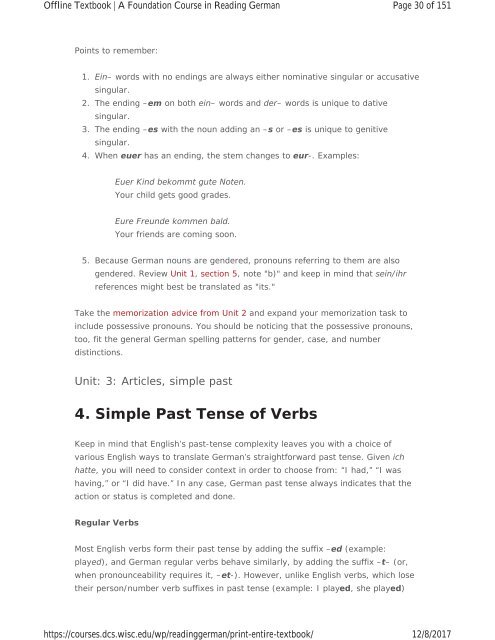A Foundation Course in Reading German, 2017a
A Foundation Course in Reading German, 2017a
A Foundation Course in Reading German, 2017a
Create successful ePaper yourself
Turn your PDF publications into a flip-book with our unique Google optimized e-Paper software.
Offl<strong>in</strong>e Textbook | A <strong>Foundation</strong> <strong>Course</strong> <strong>in</strong> Read<strong>in</strong>g <strong>German</strong><br />
https://courses.dcs.wisc.edu/wp/read<strong>in</strong>ggerman/pr<strong>in</strong>t-entire-textbook/<br />
Page 30 of 151<br />
12/8/2017<br />
Po<strong>in</strong>ts to remember:<br />
1. E<strong>in</strong>– words with no end<strong>in</strong>gs are always either nom<strong>in</strong>ative s<strong>in</strong>gular or accusative<br />
s<strong>in</strong>gular.<br />
2. The end<strong>in</strong>g –em on both e<strong>in</strong>– words and der– words is unique to dative<br />
s<strong>in</strong>gular.<br />
3. The end<strong>in</strong>g –es with the noun add<strong>in</strong>g an –s or –es is unique to genitive<br />
s<strong>in</strong>gular.<br />
4. When euer has an end<strong>in</strong>g, the stem changes to eur-. Examples:<br />
Euer K<strong>in</strong>d bekommt gute Noten.<br />
Your child gets good grades.<br />
Eure Freunde kommen bald.<br />
Your friends are com<strong>in</strong>g soon.<br />
5. Because <strong>German</strong> nouns are gendered, pronouns referr<strong>in</strong>g to them are also<br />
gendered. Review Unit 1, section 5, note "b)" and keep <strong>in</strong> m<strong>in</strong>d that se<strong>in</strong>/ihr<br />
references might best be translated as "its."<br />
Take the memorization advice from Unit 2 and expand your memorization task to<br />
<strong>in</strong>clude possessive pronouns. You should be notic<strong>in</strong>g that the possessive pronouns,<br />
too, fit the general <strong>German</strong> spell<strong>in</strong>g patterns for gender, case, and number<br />
dist<strong>in</strong>ctions.<br />
Unit: 3: Articles, simple past<br />
4. Simple Past Tense of Verbs<br />
Keep <strong>in</strong> m<strong>in</strong>d that English’s past-tense complexity leaves you with a choice of<br />
various English ways to translate <strong>German</strong>’s straightforward past tense. Given ich<br />
hatte, you will need to consider context <strong>in</strong> order to choose from: “I had,” “I was<br />
hav<strong>in</strong>g,” or “I did have.” In any case, <strong>German</strong> past tense always <strong>in</strong>dicates that the<br />
action or status is completed and done.<br />
Regular Verbs<br />
Most English verbs form their past tense by add<strong>in</strong>g the suffix –ed (example:<br />
played), and <strong>German</strong> regular verbs behave similarly, by add<strong>in</strong>g the suffix –t– (or,<br />
when pronounceability requires it, –et-). However, unlike English verbs, which lose<br />
their person/number verb suffixes <strong>in</strong> past tense (example: I played, she played)


















